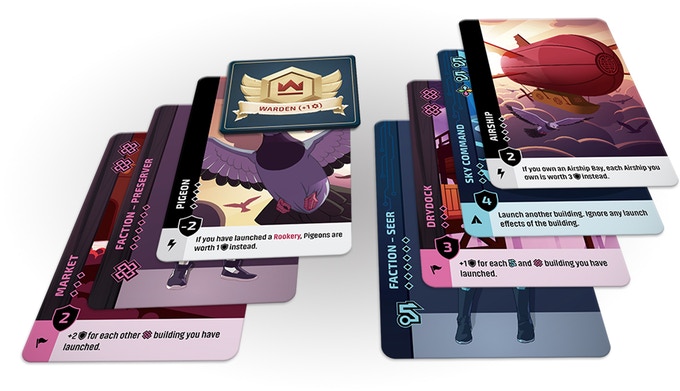
Card-based, hand-management games are becoming a dime a dozen at this point, with so many of them borrowing some or all of their mechanics from the few that have broken into the mainstream—Dominion, Machi Koro and Magic in particular—that I’ve become a card-game skeptic: I assume there’s nothing new in any such game until I see hard evidence that I’m wrong. Of the dozens of new hand-management games I saw at GenCon this year, none stuck out as much as Brendan Evans’s title Skyward, which has two mechanical twists on the hand-management framework and couples it with some of the best artwork I’ve seen on any new game this year.
Skyward is a quick-moving game for two to four players where one player in each round, called the warden, gets to divide the new cards for that round (four per player) into different piles for the remaining players to choose in a draft, placing the Warden token on one of the piles. So for a four-player game, the warden would draw 16 cards and divide them however s/he likes into four stacks—they don’t have to be even—and the other three players, in clockwise order, will each choose one stack, leaving the final one for the warden. Whoever chooses the stack with the Warden token on it gets to play that role in the next round and gets a Cog, the one type of token used in Skyward, useful for playing building cards on each turn.
The deck has just a few card types, primarily Faction cards and Building cards, each in the four main colors of the game. Faction cards function like currency, worth one or two units in their specific color, and are used to pay the price to “launch” Building cards, which generally require anywhere from one to two units to play. Most buildings require the units to be in a specific color, but some allow one or more “wild” units that can be of any color. On a turn, you discard Faction cards with sufficient units to pay the cost to launch a Building, then play that Building card to your personal Airspace. You may use Cogs to pay for some of those units as well. Many buildings give one-time or ongoing benefits, or add to your final score—including some very potent buildings that give you points based on what all of your opponents built, which can easily add up to ten or more points in a game where winning scores are generally in the 30-40 range.
There are a few other card types in the deck, largely related to points at game-end. Pigeon cards are worth -2 points each … unless you launch the one Rookery building, which converts all your Pigeons to +1 and lets every other player send one Pigeon over to you. Rocket Cat, my daughter’s favorite card by a mile, lets you send a Pigeon to any opponent. Airships are worth +2 points each, rising to +3 if you get the one Airship Bay in the deck. If you get a Pigeon or Airship card, you launch it immediately without paying any cost, and it doesn’t count against the hand limit or game-end condition of six buildings.
It should immediately occur to you that the heart of the game is in the drafting—the way the Warden chooses to divvy up the cards, trying to keep them balanced and perhaps trying to rig the piles to direct a specific card back around to him/her. You don’t want to create a pile that gives someone a building and the faction cards needed to launch it right away … unless you’re trying to distract another player from the pile you really want.
The game plays well with two, three or four, but it’s a very different game with two players because the buildings that can rack up huge bonuses in larger games are less valuable here. Your upside on a building that gives you two points for each blue building that your opponents have built is limited in a two-player game and can easily be zero. So in a head-to-head matchup, you’ll likely focus more on your own Airspace, especially in launching card combinations that give you extra bonuses—the Beacon is worth five on its own, but nine if you also build a Launching Pad—or that give you the most powerful additional abilities—the Wall is the only card that lets you launch two buildings per turn rather than one.
Skyward ends whenever any player launches his/her sixth building, although it is possible to use cards like the Wall or Lighthouse to end up with more buildings than that. Players then add up the point values of all launched buildings, Pigeons and Airships, and add any bonuses on launched Buildings. Cogs aren’t worth any points at game-end, so there’s no benefit to accumulating them for their own sake.
The Skyward box comes with two small expansions, one of which adds a substantial twist to the core game. The Allegiances expansion adds several high-point buildings that you can only launch if you have the required factions already displayed in your airspace—for example, if you have three pink and two green buildings, you can launch the Archivists card, which gets you seven points at game-end. The rules allow two variants for using the Allegiance cards, one where six are just shuffled into the main deck, but a superior option where each player starts out with three Allegiance cards, chooses one to keep for the game, and discards the other two. That way you know from the start what your Allegiance goal might be and can tailor your play to match it.
The Discords expansion is less disruptive to the core play, despite its name, with five cards that give you cascading bonuses of cogs as you collect them, and other cards that give you discounts on launching certain buildings or allow you to send a bunch of bad cards to an opponent. At game-end, however, the player with the most Discord cards on the table loses four points.
Skyward is fine for younger players, requiring some long-term thinking but with enough randomness in the card draws to allow less experienced players to keep the game close. Games take about ten minutes per player and we found mid- to high-30s scores generally win. The artwork, by Oklahoma City-based artist Ellie Jang, is spectacular, brightly colored and ornate, a sort of steampunk/manga/Jetsons mashup that’s sorely missed on the text-only Allegiance cards. Skyward may be quick to learn, but the novel mechanic and diversity of cards give it high replay value—and there’s clear space, pun intended, for a lot of future expansions.
Keith Law is a senior baseball writer for ESPN.com and an analyst on ESPN’s Baseball Tonight. You can read his baseball content at search.espn.go.com/keith-law and his personal blog the dish, covering games, literature, and more, at meadowparty.com/blog.
